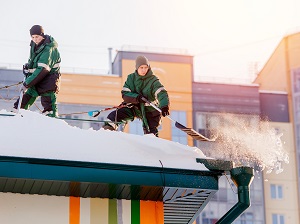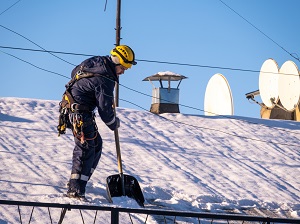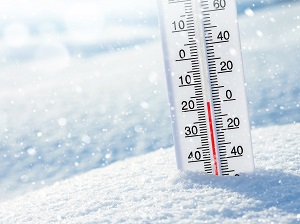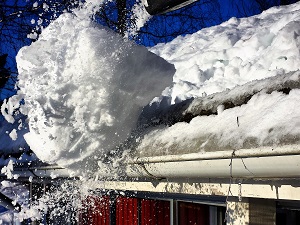Snow removal operations can result in serious injuries or fatalities—particularly while removing ice or snow from rooftops and other elevated building structures.

Snow removal operations are often performed under extreme weather conditions when it is very cold and there may be high winds and icy surfaces. Snow removal can be strenuous, particularly because cold weather can be taxing on the body, and can create the potential for exhaustion, dehydration, back injuries, or heart attacks, and can increase the risk of falls.
OSHA General Industry Standard 1910.28(b)(1)(i) The employer must ensure that each employee on a walking-working surface with an unprotected side or edge that is 4 feet or more above a lower level is protected from falling.
Snow removal may be required for a number of reasons, such as to prevent overloading and collapse, or for construction or repair of decking or roofs. Often workers climb directly onto the roofs or structures and use equipment such as shovels, snow rakes, or snow blowers. Snow removal may be performed from the ground level using snow rakes or drag lines. Aerial lifts and ladders can be used to access roofs and apply de-icing materials.
OSHA Construction Standard 1926.501(b)(1) Each employee on a walking/working surface with an unprotected side or edge which is 6 feet or more above a lower level shall be protected from falling.
Snow removal is typically a maintenance activity regulated under OSHA’s 1910 general industry standards. However, on construction sites where snow must be removed in order to begin or continue construction work, OSHA’s 1926 construction standards will apply.

Under the OSH Act’s general duty clause, employers have a duty to protect workers from recognized serious hazards in the workplace, including hazards associated with snow removal from roofs.
Falls cause the most worker fatalities and injuries during rooftop ice and snow removal. Workers can fall off roof edges, through skylights, and from ladders and aerial lifts. A dangerous roof collapse is also possible during snow removal. Fall protection equipment must be used if workers are removing snow in areas that are not adequately guarded.
Other significant hazards that can occur during snow removal:
- Amputations, eye injuries, struck by falling ice, and injuries associated with the use of snowblowers and other equipment.
- Aerial lift collapses or tip-overs.
- Entrapment and suffocation under falling snow.
- Shock or electrocution from contact with power lines or damaged extension cords.
- Frostbite or hypothermia from cold and windy conditions.
- Back injuries from slips, trips, and falls.
- Musculoskeletal injuries, exhaustion, dehydration, and heart attacks from overexertion.
- Dangers of striking hidden equipment or chemical/HVAC lines that are buried in the snow.
The unsafe use of mechanized equipment, such as snowblowers, while removing snow from roofs may cause injuries such as amputations and eye injuries. Accidents can also happen when workers are moving equipment used for snow removal to the rooftop.
Workers may face electrical hazards such as electrocution and electric shock from power lines or snow removal equipment.
Exposure to cold can cause injury and illness in workers removing snow. Cold exposure can cause frostbite (freezing in the deep layers of skin and tissue) and hypothermia (drop of body temperature to less than 95˚F). For information on how to prevent these situations, see OSHA’s Safety and Health Guide on Cold Stress.

Before snow removal operations begin:
- Plan ahead for safe snow removal and check the worksite for dangers, including fall and electrical hazards.
- Inspect all equipment before use.
- Consider using snow removal methods that do not require workers to step onto the roof or limit the number of workers that have to be on the roof.
- Confirm that the workers’ weight and any equipment used can be supported by the roof or structure without causing a collapse.
- Ensure all workers are trained to safely use the snow removal equipment, ladders, aerial lifts, fall protection, and protective gear.
Workers must know the route and method they should use to get up and down from a roof in a way that minimizes the risk of falling. The safest location for a ladder might not be the most obvious one, or an alternate method (like an access door or lift, might be available to get on the roof. Safe roof access is as important as having effective fall protection while on the roof.
Make sure that workers take steps to minimize overexertion and help prevent injuries, such as the following:
- Scoop or push small amounts of snow at a time. Use a smaller shovel or take smaller scoops of snow if snow is wet and heavy.
- Use proper form if lifting is necessary; keep the back straight and lift with the legs.
- Do not overload the snowblower; let it operate at a modest speed.
- Take frequent breaks and drink fluids (avoid caffeine or alcohol).

To prevent falls from ladders used for accessing roofs:
- Workers should not use a snow rake or shovel while on a ladder because this greatly increases the risk of losing one’s balance and falling.
- Check the ladder rungs for ice. A slippery step can cause a fatal fall.
- Clean snow from shoes or boots before mounting the ladder.
- Ensure the ladder has level and secure footing.
- Do not carry heavy or bulky loads up a ladder. Instead climb up the ladder first, and then pull the equipment up to the working level with a rope or other appropriate hoisting method.
OSHA Standards 1926.1053(b)(6) and 1910.23(c)(4) Ladders shall be used only on stable and level surfaces unless secured to prevent accidental displacement.
To prevent unbalanced loading during snow removal, workers should remove snow uniformly across the roof and avoid making snow piles on the roof.
Protect people on the ground during snow removal. Mark a safe work zone and keep people back at least 10 feet from the point where snow is expected to be blown or fall. When using snow rakes, remove small amounts of snow at a time.

.jpeg)

